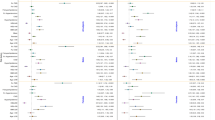Abstract
The aim of the present study was to examine the relationship between the novel single nucleotide polymorphism, 698C>T that causes an amino acid change from proline to leucine at codon 233 and type 2 diabetes mellitus (T2DM) in the Saudi population. From the general population in the Saudi Arabia a total of 551 samples were collected and categorized them as T2DM (n = 376) and healthy controls (n = 175). Five ml of the blood sample was collected and used for the Biochemical and Molecular analysis. With the help of serum sample lipid profile: Fasting blood sugar (FBS), Total Cholesterol (TC), Triglycerides (TG), High Density Lipoprotein Cholesterol (HDL-C), Low Density Lipoprotein Cholesterol (LDL-C) and VLDL were performed. PCR–RFLP was performed after separating the genomic DNA from the EDTA blood. The genotype distribution of C698T polymorphism was performed by the Chi square test with SPSS version 16.0 software for comparing T2DM subjects and healthy controls. In our study, genotypic distributions of C5L2 C698T polymorphism and allele frequency of patients and controls were found to be significant difference in the allele and the genotypic distribution. [For T Vs C; p = 0.01; Odds ratio = 3.594 (95 % CI; 1.256–10.28); and CT+TT Vs CC; p = 0.009; Odds ratio = 3.707 (95 % CI; 1.285–10.69)]. TT genotype was completely absent in both the cases and the controls. In conclusion, our study indicates that 698C>T polymorphism of C5L2 gene is associated with the T2DM in individuals of Saudi population which was found to be similar with other studies.
Similar content being viewed by others
References
Rai E, Sharma S, Kaul S, Jain K, Matharoo K, Bhanwer AS, Bamezai RN (2012) The interactive effect of SIRT1 promoter region polymorphism on type 2 diabetes susceptibility in the north Indian population. PLoS One 7:e48621
Diabetes Atlas (2012) International Diabetes Federation, USA
Borges JL, Bilezikian JP, Jones-Leone AR, Acusta AP, Ambery PD, Nino AJ, Grosse M, Fitzpatrick LA, Cobitz AR (2011) A randomized, parallel group, double-blind, multicenter study comparing the efficacy and safety of Avandamet (rosiglitazone/metformin) and metformin on long-term glycemic control and bone mineral density after 80 weeks of treatment in drug-naïve type 2 diabetes mellitus patients. Diabetes Obes Metab 13:1036–1046
Saxena M, Srivastava N, Banerjee M (2012) Genetic association of adiponectin gene polymorphisms (+45T/G and +10211T/G) with type 2 diabetes in North Indians. Diabetes Metab Syndr 6:65–69
Mathias RA, Deepa M, Deepa R, Wilson AF, Mohan V (2009) Heritability of quantitative traits associated with type 2 diabetes mellitus in large multiplex families from South India. Metabolism 58:1439–1445
Prokopenko I, McCarthy MI, Lindgren CM (2008) Type 2 diabetes: new genes, new understanding. Trends Genet 24:613–621
Yin YW, Zhang YD, Wang JZ, Li BH, Yang QW, Fang CQ, Gao CY, Li JC, Zhang LL (2012) Association between apolipoprotein E gene polymorphism and the risk of multiple sclerosis: a meta-analysis of 6977 subjects. Gene 511:12–17
Ginter E, Simko V (2010) Diabetes type 2 pandemic in 21st century. Bratisl Lek Listy 111:134–137
Alhyas L, Cai Y, Majeed A (2012) Type 2 diabetes care for patients in a tertiary care setting in UAE: a retrospective cohort study. RSM Short Rep 3(10):1258
International Diabetes Federation (2011) IDF Diabetes Atlas, 4th ed International Diabetes Federation
Zheng YY, Xie X, Ma YT, Yang YN, Fu ZY, Li XM, Ma X, Chen BD et al (2012) Relationship between type 2 diabetes mellitus and a novel polymorphism C698T in C5L2 in Chinese Han population. Endocrine 41:296–301
Zheng YY, Xie X, Ma YT, Yang YN, Fu ZN, Li XM, Ma X et al (2011) Relationship between a novel polymorphism of the C5L2 gene and coronary artery disease. PLoS One 6:e20984
Polderman KH, Gooren LJ, Asscheman H et al (1994) Induction of insulin resistance by androgens and estrogens. J Clin Endocrinol Metab 79:265–271
Muraki K, Okuya S, Tanizawa Y (2006) Estrogen receptor alpha regulates insulin sensitivity through IRS-1 tyrosine phosphorylation in mature 3T3–L1 adipocytes. Endocr J 53:841–851
Cianflone K (2003) Acylation stimulating protein and triacylglycerol synthesis: potential drug targets? Curr Pharm Dis 9:1397–1410
Huertas-Vazquez A, Aguilar-Salinas C, Lusis AJ, Cantor RM, Canizales-Quinteros S et al (2005) Familial combined hyperlipidemia in Mexicans: association with upstream transcription factor 1 and linkage on chromosome 16q24.1. Arterioscler Thromb Vasc Biol 25:1985–1991
Genest JJ Jr, Martin-Munley SS, McNamara JR, Ordovas JM, Jenner J, Myers RH, Silberman SR, Wilson PW, Salem DN, Schaefer EJ (1992) Familial lipoprotein disorders in patients with premature coronary artery disease. Circulation 85:2025–2033
Acknowledgments
The authors would like to extend their sincere appreciation to the Deanship of Scientific Research at King Saud University for its funding of this research through the Research Group Project no RGP-VPP-244.
Conflict of interest
Authors declare that there is no conflict of Interest.
Author information
Authors and Affiliations
Corresponding author
Rights and permissions
About this article
Cite this article
Alharbi, K.K., Khan, I.A. & Syed, R. Circulating C5L2 gene polymorphism is associated with type 2 diabetes mellitus in Saudi population. Mol Biol Rep 40, 6323–6327 (2013). https://doi.org/10.1007/s11033-013-2745-6
Received:
Accepted:
Published:
Issue Date:
DOI: https://doi.org/10.1007/s11033-013-2745-6




